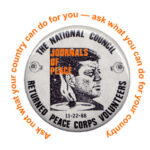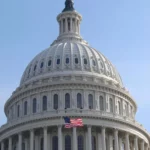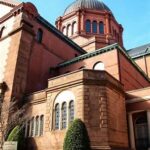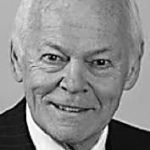Journals of Peace by Tim Carroll (Nigeria)
 by Tim Carroll (Nigeria 1963–66)
by Tim Carroll (Nigeria 1963–66)
In 1988, as the first d Director of the National Council of Returned Peace Corps Volunteers (NCRPCV), now the National Peace Corps Association, I felt a considerable part of my mandate was to bring our disparate numbers together, to gather us up to celebrate those feelings we had in common. A number of special events given under my tenure accomplished this in varying degrees of success, but none held the hearts of Peace Corps family as did the Journals of Peace.
As the 25th anniversary of the death of President John Kennedy — the founder and much loved hero of early Volunteers — approached, I made a call to St. Matthew’s Cathedral, the church that had been the site of JFK’s funeral service, and asked if we might have a memorial Mass that would include not only the traditional Showing of the Colors, but a procession of flags, carried by returned Volunteers, representing all their countries of service. The priests quickly agreed.
Then in a conversation with John Coyne (Ethiopia 1962–64), he mentioned how many PCVs had kept journals while overseas and suggested we might have RPCVs read from their journals for twenty-four hours before the memorial Mass at the Cathedral.
When this proved to be impossible at St. Matthews, I called Connecticut Senator Chris Dodd (Dominican Republic 1966–68)) and asked if it might be possible to stage such a vigil in the Capital Rotrunda. Holding a 24-hour vigil in the Rotunda of the U.S Capitol had never happened before,(at that time the Capitol Rotunda was open to the public from 9:00 am to 4:30 pm) but the good Senator made it happened.
RPCVs respond to the invitation
Next we put out a call to RPCVs around the world and asked them to come to Washington, D.C. on November 21, 1988 and remember John F. Kennedy and their service for America in the Peace Corps by reading from their journals. So began the Journals of Peace.
The response from the RPCV community was overwhelming and was almost more than the nascent staff at the NCRCV could handle. That staff included Kitty Thuermer (Mali 1977–79), Jeff Drumtra (Niger 1978–80), Mark Hallett (Philippines 1983–85), Laura Byergo, (PC/Staff Burndi), Geoffrey Greenwell (Zaire 1986–87), and Michael McGirr (Sierra Leone 1977-80) who was the Journals of Peace Director. Many others donated their time, including Dennis Grubb (Colombia 1961–63), who handled the press for the event.
Returned Volunteers from across the nation, hearing about the opportunity of reading a minute or two from their journals, signed up in the hundreds and quickly filled the 24-hour time slots with their three-minute readings.
The Journals of Peace
 From mid-afternoon on November 21, 1988 until it was time for the Mass to begin the following day, Volunteers of all sizes, shapes and ages read inspiringly from their journals, or retrieved from their memories, fragments for what had been for them the defining moments of their young lives. Through the night it continued, each story, each anecdote another piece of the message: when you are working for others your own life is enlarged, enhanced and made memorable.
From mid-afternoon on November 21, 1988 until it was time for the Mass to begin the following day, Volunteers of all sizes, shapes and ages read inspiringly from their journals, or retrieved from their memories, fragments for what had been for them the defining moments of their young lives. Through the night it continued, each story, each anecdote another piece of the message: when you are working for others your own life is enlarged, enhanced and made memorable.
We gave the final time slot to then-Director of the Peace Corps, Loret Miller Ruppe, who, while not a Returned Volunteer, had in her eight year’s as head of the agency, come to reflect the attributes Volunteers respected, among them that peace was more important than politics.
A Service of Remembrance
When Loret finished her presentation, there was a seamless transition to the cathedral. There the first Director of the Peace Corps, Sargent Shriver; his deputy, Bill Moyers; and Father Theodore Hesburgh, a former Peace Corps adviser and president emeritus of President of Notre Dame, were among the officials presiding over the service.
 Over 1,500 attended this service of remembrance at St. Matthew’s where Father Hesburgh, would remark in his homily, “I think if Kennedy were standing here today, his hair probably white like mine, he would say, ‘You are the people that took the best message that I gave to the world. You understood what it meant to serve.’”
Over 1,500 attended this service of remembrance at St. Matthew’s where Father Hesburgh, would remark in his homily, “I think if Kennedy were standing here today, his hair probably white like mine, he would say, ‘You are the people that took the best message that I gave to the world. You understood what it meant to serve.’”
Bill Moyers recalled the 1960s in his tribute to Kennedy. “I hear the sounds of crowds cheering and cities burning, of laughing children and weeping widows, of nightriders, nightmares and napalm, of falling barriers and new beginnings and animosities as old as Cain and Abel . . . . But something survived those years which bullets could not stop. An idea survived, embodied in the Peace Corps . . . Out there, John F. Kennedy might say, is the new frontier.”
A handful of RPCVs — Peggy Anderson (Togo 1962–64), John Coyne (Ethiopia 1962–64), Paul Tsongas (Ethiopia 1962–64) and Roger Landrum (Nigeria 1961–63) — were asked to say a few words in the Cathedral which acted as a Coda to the Journals of Peace.
Following the service of remembrance, Peace Corps Director Ruppe hosted a reception for all the participants at the Peace Corps Headquarters, which was then located at 1990 K Street.
In addition to being a Peace Corps Volunteer in Nigeria from 1963-65, Tim Carroll was also the Peace Corps Country Director in Pakistan, Poland and Russia between 1990 and 1995. For a decade of work with Eye Care, Inc. in Haiti, Tim received the first Shriver Award for Humanitarian Service in 1986. After founding the Office of Protocol for the Department of Justice, (1997-01), Tim Carroll retired to his family farm in Michigan. He continues his interest in international affairs and travels widely.
Two Washington Post articles about the readings

As a west coast freelancer who applied for the initial editorship of WorldView magazine Tim Carroll arranged for my interview in DC. My recollection of him and the dedicated staff he had gathered in the preInternet mid-1980s was highly positive and I returned home feeling that the fledgling National Council (NCRPCV) was in good hands, even though I failed to secure the position. Thank you again Tim and I hope life is treating you and your loved ones well during these trying pandemic times.
Since I could not later attend the 1988 Service of Remembrance I was happy to read about it here (thank you John for sharing).
Best wishes to all my RPCV brethren,
Vic Cox
(Brazil 1964-66)
The Capitol Rotunda and the Cathedral service must have been wonderful events and gestures towards peace for all humankind. Thanks Tim Carroll—for your visionary thinking in arranging this magnificent tribute to our Man–JFK..
It was a wonderful event – thank you Tim for all you have done for PC over the years.
A Modern Parable? by Edward Mycue (an early PC Volunteer, Ghana 1961)
Long ago –yesterday– 1960, I came up from North Texas State in Denton to Boston University and a Lowell Fellow intern at WGBH-TV the then New England Television station
then at M.I.T. Cambridge just over the Charles River from Boston on Massachusetts Avenue above a former roller rink as
As Louis Lyons assistant on his twice weekly 14:28 second programs of News and the other of profiles and special subjects. In the summer June 1960, the technical assistant, I began on his many programs about Senator J F Kennedy and others in their reaches for their Party’s nominations — Harold Stassen was Republican perennial nomination seeker. Hubert Humphrey, Adalai Stevenson, Mrs Eleanor Roosevelt, Robert Kennedy… came on and often there was talk of what would be the PEACE CORPS.
The next year, still on the job I took the test, and in time, in June the call to go to Ghana and I went first to Berkeley for training.. At the end of August I headed up to D.C. before heading off in that 2 engine prop Covair to the Azores, Dakar in Senegal..
In Washington D.C. then Ghana my contingent of 50 went up to the White House and met Kennedy (for my third time since I’d met him when he was a Senator seeking the Party nod and then in the Fall as the Democrat Party candidate).
Peace is not assured nor may it ever be, but it is still to sought. I was born in Niagara Falls, NY in 1937 in a Depression when WAR in Europe and WAR in the Pacific was already swelling and staining the world, our planet. War continues and also now also while peoples and countries battle. T
There are pandemics and illness that are endemic along with possibly also through weather, climate, life’s end, and possibly (it is not far fetched to suggest) the demise of our planet.
It used to be in the phrase from The Group, a novel by Mary McCarthy, “Who’d a thunk it” only IN THOSE farfetched Science Fiction pulp stories and novels.
Edward Mycue, 3595 Geary Blvd, Apt.#320, San Francisco CA 94118 (415) 387-2471
(C) Copyright Edward Mycue 24/VII/22 Sunday morning
Tim,
Our Peace Corps community remains in debt to your continuous long-term commitment to historically record and sustain its ideal from those opening days on the steps of the University of Michigan’s Student Union to those august steps into St. Mathew’s Cathedral in Washington D. C. Thank you.
YOU ARE A WORRIOR , WE NEED MORE OF YOUR TYPE , RESPECT DADDY